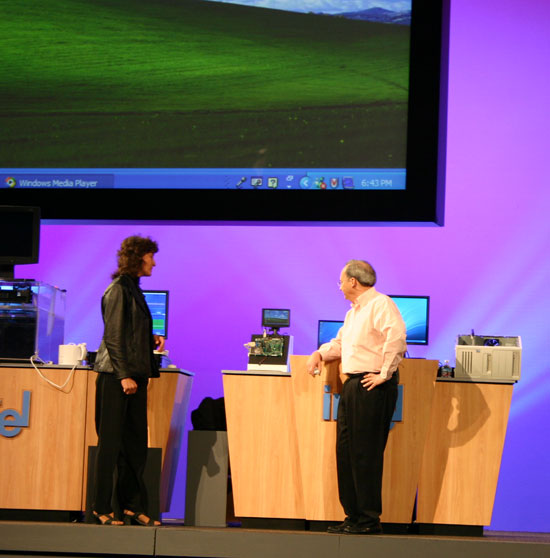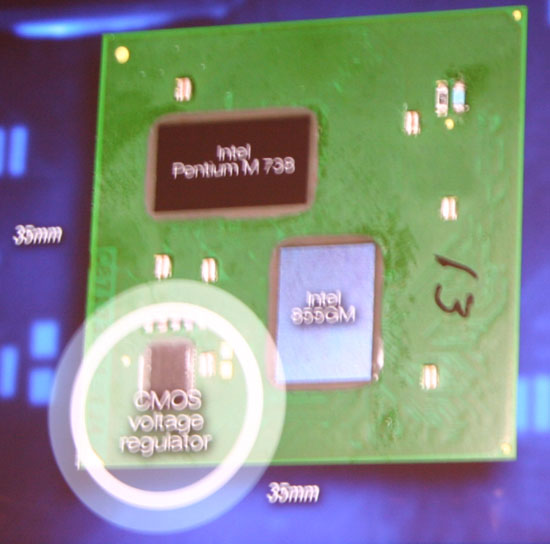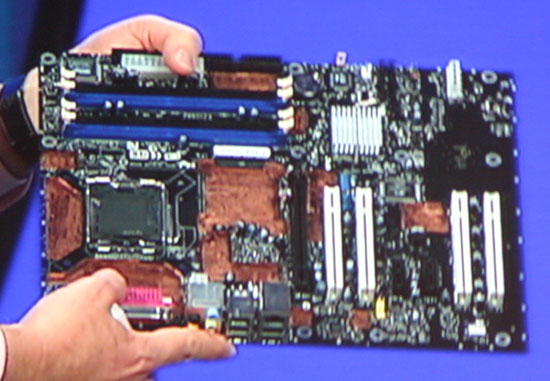Fall IDF 2005 - Day 3: Intel Demos On-Chip North Bridge & Voltage Regulator
by Anand Lal Shimpi on August 25, 2005 12:39 PM EST- Posted in
- Trade Shows
One of the biggest performance and technology advantages AMD has hold over Intel has been their on-die memory controller and North Bridge. Not only does AMD's on-die memory controller increase performance, but it saves overall system power as it can take advantage of the CPU's power management and advancements in microprocessor manufacturing technology.

Intel went in a slightly different direction today and showcased a research project of a Pentium M processor with an on-package GMCH, or North Bridge with integrated graphics.

Obviously this is different from doing an on-die north bridge, but you do get some significant performance benefits from moving the GMCH on chip. Note that the graphics core is also on the package, which is something we've heard AMD may be working on, but we were actually able to see a working demo from Intel today.

The integration went one step further, and included an on-package CMOS voltage regulator. The idea behind this integration step is that conventional voltage regulators on motherboards are relatively slow, they can't switch between voltage levels too quickly. They especially can't switch at the same rate as CPU demand changes:

Current Technology, the green line represents voltage and the blue spikes represent CPU demand
By moving to an on-package CMOS voltage regulator you not only simplify the motherboard, but you also get much faster voltage switching, meaning the voltage regulator can actually switch more frequently with CPU demand - resulting in something like the graph below.

CMOS based voltage regulators will enable much finer grained switching
Intel didn't commit to a timeframe of introducing this technology, but given that they had working silicon, we can expect that this project is something they truly wish to pursue.

A prototype motherboard using the technology. Note the lack of voltage regulators on the motherboard and the missing GMCH (North Bridge) chip.










36 Comments
View All Comments
erinlegault - Thursday, August 25, 2005 - link
I agree, the overall complexity of the PCB (which will have a lot more layers than the current 6 or 4 norm) will definately be cost prohibitive. Like you said notebooks, tablets, PDA/Blackberry's next iteration, cell phones, etc. will definately improve.The on die graphics and northbridge would also be welcome. I have a feeling ATI is working on such a project. Imageon is just the start, eventhough it is geared for cell phones.
4AcesIII - Thursday, August 25, 2005 - link
That's all we need ATI doing this too, they gonna make cpu's now too? They can't even put out a decent driver for their hardware how are they going to SUCESSFULLY combine all these things onto one pcb? What could be worse than Intel trying this you say, well our friend here has pointed out what that could be.Cybercat - Thursday, August 25, 2005 - link
Nomatter how close Intel moves the graphics chipset to the CPU, it will still perform like crap. Not like they care. They're making a killing off of them anyhow.brownba - Thursday, August 25, 2005 - link
they don't care because graphics performance doesn't matter for business Office usersothercents - Thursday, August 25, 2005 - link
Typically motherboards allow you to up the voltage given to the processor. By adding the Voltage regulator to the processor you no longer have the option to up the voltage. Which will keep you from being able to overlock the processor. This sounds like a great idea for Business machines, but I'm not sure if the the on die voltage regulator is going to help enough on heat to take away the ability to overclock the processor.Other
4AcesIII - Thursday, August 25, 2005 - link
Do these Anand folks understand that recent theory on focus? What's up with the pictures you can't see a thing, what did they do take a trip with their webcams? It's about as impressive as this crock that intel is putting forth, what if I don't want a freakin graphics core on the die or anything close to it. Why make me pay for what has historically been CRAP video when it will never be used, just like this viva junk, MCE isn't a good thing in my opinion and I'm not going to buy some processor that FORCES me to use a crippled OS.kmmatney - Friday, August 26, 2005 - link
whine, whine, whine...joex444 - Friday, August 26, 2005 - link
it would be whining if there wasn't an alternative cpu to purchase...Furen - Thursday, August 25, 2005 - link
Bah, it's not even on die, they're just packaging it together. I wonder if there are any significant improvements on performance, though I do understand it will lower motherboard's complexity.Ged - Saturday, August 27, 2005 - link
Yeah. Are they making all the components with the same process? or is it a 110nm voltage regulator, 90 nm northbridge and a 65nm cpu?
It's really not "on-chip", more like "on chip module".
the voltage regulator looks very nice. I like that. I guess the question is will they get the same performance as if it were really "on-chip"?